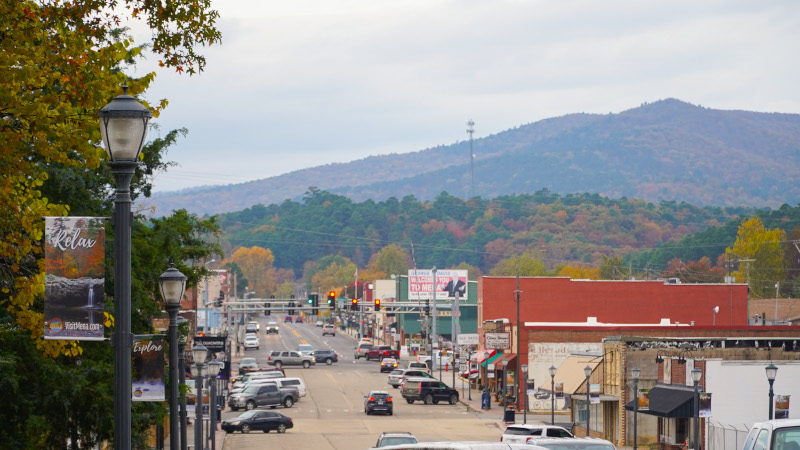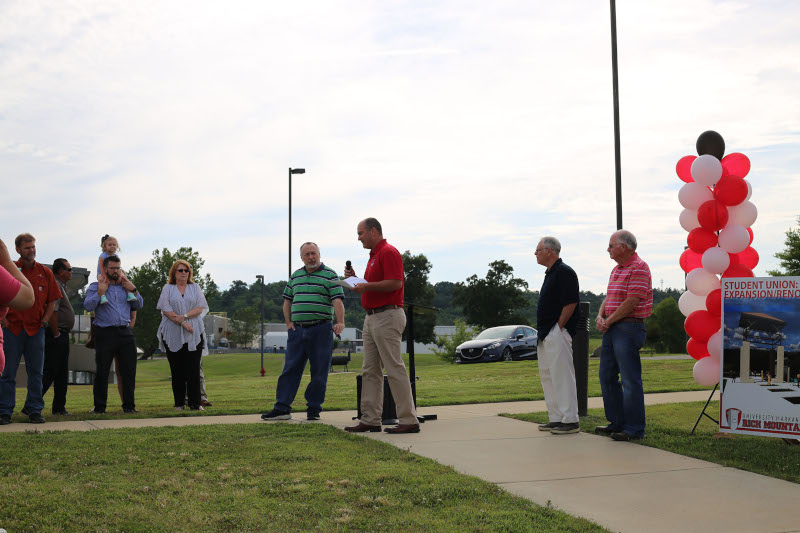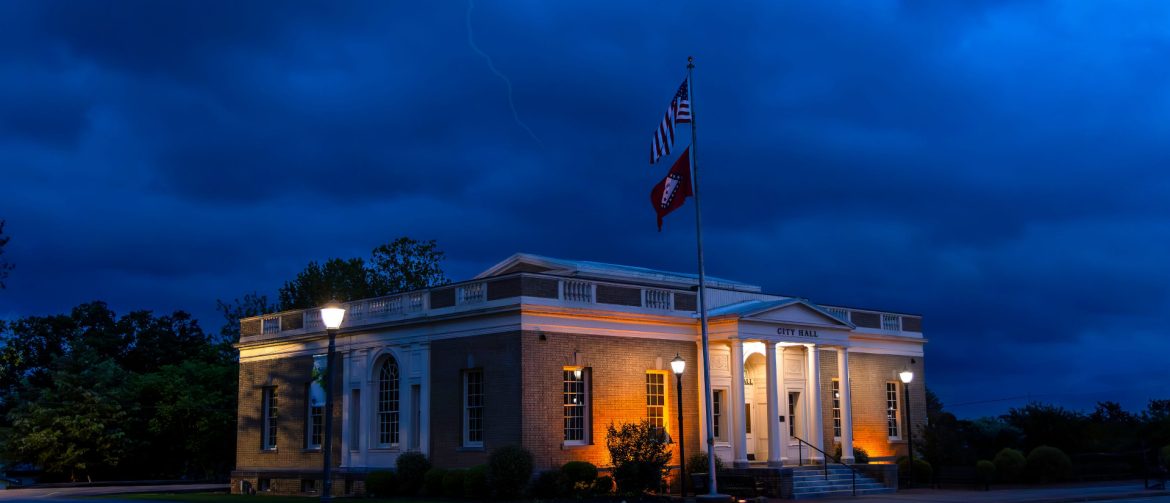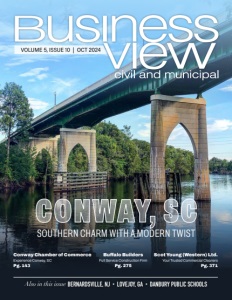Mena, Arkansas
Driven by Community and Vision
Expertly designing a future that balances small-town charm with big opportunities.
Mena, Arkansas, is a small city that thrives on its unique position in the state. It’s not a suburb leaning on a larger urban area; instead, it stands independently, an hour and a half from any major city. Despite—or perhaps because of—this geographic isolation, the people of Mena have developed a strong sense of unity and self-reliance.
Mayor Seth Smith doesn’t mince words when describing the city’s greatest strength. “We all come together when something’s needed,” he says, highlighting how collaboration between local and state levels is stronger now than ever. The mayor’s roots run deep in the community—his experience with the Polk County Sheriff’s Office and fire department gives him a unique vantage point on the city’s growth. “Strength in numbers,” he says, “when you have strength in numbers, you can move mountains.”
And moving mountains is precisely what the city is doing, though in a different sense. Mena, Arkansas, is developing a major mountain biking destination on Rich Mountain, the state’s second-highest peak. Mayor Smith describes the project as a collaborative effort involving the Arkansas Parks and Recreation Foundation, Arkansas State Parks, and the United States Federal Forest Service. The city, which owns 160 acres at the mountain’s base, has already constructed four miles of trails set to open soon.
The ambitious plan aims to develop 120 miles of lift-access trails, potentially transforming Mena into a regional hub for outdoor enthusiasts. The trail network will wind through 8,800 acres of Federal Forest Service land, connecting Mena to the Queen Wilhelmina State Park at the summit, known for its stunning views. The mayor spotlights the project’s uniqueness: “You have three landowners involved—the city, the state parks, and the federal government—all working together on this.” Final approval is expected by early 2025.
Revitalizing Downtown
Mena’s downtown is not just a hub for commerce; here, the city focuses significantly on improving the quality of life and boosting the local economy. Mayor Smith speaks with ambition and pragmatism, particularly when it comes to making the area more walkable, accessible, and visually appealing.
“Most of our downtown, on Main Street, we already have ten-foot sidewalks,” he explains, pointing out that Mena is ahead of the curve in terms of accessibility. These wide sidewalks comply with the Americans with Disabilities Act (ADA), except for about 2,000 linear feet. However, there’s already a plan in motion to address that gap. “We applied for a grant to extend the streetscape, and we got it,” he says, referring to a project stretching these wide sidewalks to what the locals call “the gateway,” the starting point for the climb up Rich Mountain.
The streetscape project in Mena goes beyond sidewalks, including decorative light poles to enhance the downtown atmosphere. Mayor Smith envisions a city where pedestrian and bicycle routes connect every central point of interest. “We applied for a $3.5 million planning grant to connect every major point of interest in Mena via bicycle and pedestrian paths,” he explains. Although the town did not secure the grant this year, the project was deemed a “project of merit,” offering valuable feedback for future applications. The mayor remains optimistic, eyeing a $25 million RAISE grant that could transform Mena.
Alcohol Policy Changes
Mena’s journey from a dry county to one that allows alcohol sales has significantly impacted its residents and appeal to visitors. In 2019, when Mayor Smith first took office, alcohol availability was tightly controlled. “We were considered a dry county, which means you couldn’t serve alcohol,” he explains. At the time, there were only five private club licenses in the city, with a few more scattered across Polk County.
Recent legislative changes have opened new doors, particularly for businesses like microbreweries. The mayor recalls working with a local business owner to navigate the state regulations and help establish what may have been the first—or certainly one of the first—microbreweries in a dry county in Arkansas. “We started working with a local business owner on that, and he was the driving force behind it,” Smith says. The microbrewery, known as The Ouachitas, helped shift local attitudes toward alcohol sales and set the stage for future changes.
Mena has also introduced temporary entertainment districts allowing alcohol consumption at specific events, with safety measures in place. The city passed a countywide vote on alcohol sales with 60% approval, allowing stores to opt-in. “Now we have alcohol being sold in whatever stores choose to take advantage of that,” the mayor explains, aiming to boost tourism and local appeal. Increased tax revenue from alcohol sales funds community projects, while other developments, like a new asphalt plant, are accelerating infrastructure improvements. “You just start seeing things pop up, and it helps the tax revenue,” he notes.

Investing in Infrastructure
Mena’s infrastructure isn’t just about roads and utilities—it’s the backbone that supports public safety, parks, and long-term economic growth. Mayor Smith offers a broad perspective, reminding people that infrastructure includes essential services like police and fire departments.
“From a city standpoint, I want to keep a small footprint on what we offer and what we do, but that’s also part of infrastructure,” he says. For example, the police force recently expanded, but not due to an uptick in crime. “We just hired another officer,” the mayor explains, emphasizing that the addition is about maintaining flexibility in scheduling.
Now, with three officers on every shift, the city is better equipped to handle the day-to-day demands without the stress of scrambling to fill gaps when someone calls in sick or takes vacation. The investment extends beyond staffing, though. Mena’s officers were previously working out of a cramped 1,600-square-foot space. Today, they’ve been relocated to a 5,500-square-foot building.
Mena has heavily invested in its fire department, acquiring new equipment like a $176,000 brush truck and a $926,000 pumper truck. “We’re always investing in our police and fire departments,” says Mayor Smith. They’ve added an ATV and mountain bike response equipment to support the city’s expanding trail system. Investments extend to parks, with new splash pads, playgrounds, and ball field upgrades. “We’ve made lots of investments in our parks,” he adds.
Mena has also bought street maintenance equipment without financing, a point of pride for Mayor Smith: “We haven’t had to do loans.” However, larger projects like water and sewer system upgrades required taking out a bond, costing $20-40 million. Mena also allocates about half a million dollars annually for street maintenance, with the mayor noting, “Our streets are fantastic for a town of our size.”
Building a Business Ecosystem
Attracting and sustaining commercial activity in Mena requires a nuanced approach. Mayor Smith acknowledges that while the city might be “in the middle of nowhere,” it still draws workers from surrounding counties to its major employers.
“We have multiple people from surrounding counties that come in to work at our facilities,” he says, pointing to key players like Nidec, a large manufacturing plant that employs around 300 people, and the local hospital, which staffs between 275 and 325 depending on its caseload. The area also boasts several machining companies that produce specialized parts, from engine blocks to elevator components. However, Smith is careful not to overemphasize this type of industry as the city’s future.
“I don’t think that we’re ever going to get another big factory like that here,” he admits. And for him, that’s not necessarily a bad thing. The risks of relying on a large, single employer are too significant. “If one of your major manufacturing facilities that employs several hundred people shuts down, that’s a hard pill to swallow,” he explains. Instead, he sees the future in nurturing small businesses, particularly those with 5 to 25 employees. If a smaller venture closes its doors, it doesn’t devastate the community similarly.
In addition to supporting small businesses, Mayor Smith envisions Mena becoming a hub for tourism and outdoor recreation, with the development of mountain bike trails creating opportunities for young entrepreneurs. “You’re talking outdoor outfitters, equipment, gear, clothing, souvenir shops,” he says, predicting a boom in businesses tied to adventure tourism. While larger projects like lift-access trails are still in progress, he is optimistic. He also notes the potential for shuttle services, as “people aren’t going to want to ride their bike all the way up to the top.”
A conversation with a state official highlighted the airport’s role, as some tourists might arrive by private plane. “If they don’t pull a mountain bike off their plane, they’re going to want a quality rental,” the mayor explains, opening up rental and transportation services possibilities. Mayor Smith foresees Mena becoming a haven for entrepreneurs, stating, “There’s just so many things to think about and what’s going to snowball on these mountain bike trails.”
A Hidden Economic Powerhouse
Mena’s airport, often flying under the radar for those unfamiliar with the area, is a major economic engine for the city. Mayor Smith describes it as more than just a facility for private flights; it’s a full-fledged aviation hub with a wide range of capabilities. “You can essentially bring a plane in on a trailer in parts, and you will be able to fly it out of our airport,” he says. The airport supports airframe construction, avionics, painting, and almost any repair or customization the plane needs.
This versatility has turned the airport into a vital industry for Mena. Planes that arrive in pieces leave fully operational due to the facility’s technical skill and industrial capacity. “It’s a massive, massive industry and a big economic driver,” the mayor states. The numbers back up his claim. A study conducted by the Arkansas Aeronautical Association several years ago estimated the airport’s economic impact at an impressive $49.5 million, ranking it among the top two or three aviation contributors in the state.
Mayor Smith sees even more tremendous potential for Mena’s airport. “If the bike trails kick off, we’re going to look at turning our airport into a regional hub,” he says. Despite FAA regulations, the mayor is keen to explore regional flights connecting Mena to cities like Dallas, Oklahoma City, Memphis, or Little Rock. We could have those short flights,” he notes. With the airport’s expansion, Mena could become a key destination for adventure tourism, driving further economic growth.

Building the Workforce of Tomorrow
For a community like Mena, the strength of the school district is crucial not just for attracting families but also for sustaining the local economy. Dr. Lee Smith, Superintendent at Mena Public Schools, emphasizes the seamless collaboration between the city and the school district, describing it as a “cohesive” partnership. “The relationship with the city is really good,” he says, echoing Mayor Smith’s earlier comments about how local leaders work together to move initiatives forward. This spirit of collaboration is essential, especially regarding workforce development.
The Mena school district is creating a skilled workforce to meet local industry needs, reversing the “college for all” mindset favoring vocational careers. “We are trying to revive the skilled trades and vocations,” Dr. Smith says, emphasizing the importance of hands-on work that benefits the community. Programs like the district’s agriculture curriculum teach basic mechanics, while the University of Arkansas Rich Mountain focuses on advanced skills. The machine tool program, in particular, is so successful that “most of the students get hired away before they graduate.”
Beyond mechanics, the district offers family and consumer science programs, business courses, and a pre-educator program to foster local talent. The district’s efforts go hand-in-hand with community pride and economic development. “Much of the ESSER funds that we had were spent locally,” Dr. Smith notes, stimulating the economy. With the state’s new starting teacher salary of $50,000, the district has improved living standards despite inflation. Dr. Smith explains the focus on reinvesting: “We need to not hoard money as a school system but put it to work in our people’s hands.”
Addressing the Housing Challenge
Residential development in Mena faces the same obstacles many communities grapple with: high interest rates and skyrocketing material costs. Mayor Smith acknowledges that these factors have slowed local construction efforts. “We have one residential contractor with a subdivision laid out with the infrastructure work done, but only one house has been built so far,” he says. The demand is there, but the rising cost of building has made progress difficult. The contractor is holding off on additional homes until he can sell the remaining lots, a common trend in the current housing market.
To better understand how the city can address this challenge, a local group is preparing to launch a housing study. “They’re in the very early stages of starting that next month,” the mayor explains. The study will assess the types of housing Mena needs most—whether that’s traditional three-bedroom, two-bathroom homes or smaller, more affordable options like apartments or two-bedroom units. The hope is that this study will help guide future development by pinpointing what would best fit Mena’s growing community.
Mena also needs more skilled trades like plumbing, electrical work, and construction, which are crucial for the city’s growth. “It just seems like there’s not so many people that are interested in learning that trade,” Mayor Smith notes. He is hopeful that younger residents will recognize these opportunities, stating, “There’s definitely going to be an opportunity for anyone looking for that type of skilled trade.” Dr. Smith echoes this, emphasizing the district’s push toward vocational training over a “college for all” mindset. These programs aim to fill the city’s growing need for electricians, plumbers, and builders to support future development.
Priorities for the Future
As Mena moves forward, the school district and the city focus on clear, actionable goals to improve quality of life and prepare for future growth. Dr. Smith identifies academic achievement as the school district’s top priority.
“We’re trying to get the number of students reading on grade level to increase quite a bit,” he says. The district is returning to the basics, ensuring that foundational reading, writing, and arithmetic skills are a central focus. While Mena’s schools already perform well, Dr. Smith hopes to push them further. “We want more to leave here with higher academic success,” he states.
Mayor Smith prioritizes infrastructure plans for the city, especially the bike-pedestrian initiative. “I think we have good plans in place,” he says but recognizes the challenge of securing resources. As Mena becomes more pedestrian-friendly, the mayor sees the need to educate drivers and redesign areas for safety. “We need more education on our vehicular traffic on what’s expected,” he notes. Thoughtful planning will help balance pedestrian and vehicle traffic. With potential grant funding on the horizon, the mayor remains optimistic: “If it’s a project of merit, we have plans, but they always change,” reflecting Mena’s adaptable approach to growth.
AT A GLANCE
Mena, Arkansas
What: A growing city focused on infrastructure, education, and outdoor tourism development
Where: Polk County, Arkansas
Website: https://cityofmena.org/
PREFERRED VENDORS
Mena Public School – https://www.menaschools.org/
Mena Public Schools serves over 1,700 students in a rural community supported by agriculture, manufacturing, service, and retail industries. We provide a high-quality education, fostering personal growth and success through professional development, innovative teaching methods, and community collaboration to prepare students for prosperous futures in diverse career fields.



